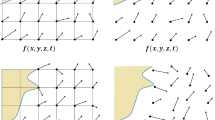Abstract
Particle image velocimetry (PIV) offers a new possibility for turbulence kinetic energy dissipation rate measurements. It can be used for the estimation of the turbulent kinetic energy dissipation rate using its definitions. Dissipation rate definitions include spatial derivatives of the velocity fluctuation components. Two different estimates for two-dimensional and isotropic definitions calculated from PIV results have been compared with direct numerical simulations in one case. Results show that the spatial resolution achieved is a critical factor in the accuracy of the computed dissipation rate. An error in velocity measurements can dominate the measured dissipation rate. The optimal result for the estimate will be achieved if the interrogation area is neither too large (under-sampling phenomenon) nor too small (noise in the measurement data/physical limits of the PIV system).
Similar content being viewed by others
Author information
Authors and Affiliations
Rights and permissions
About this article
Cite this article
Saarenrinne, P., Piirto, M. Turbulent kinetic energy dissipation rate estimation from PIV velocity vector fields. Experiments in Fluids 29 (Suppl 1), S300–S307 (2000). https://doi.org/10.1007/s003480070032
Issue Date:
DOI: https://doi.org/10.1007/s003480070032




